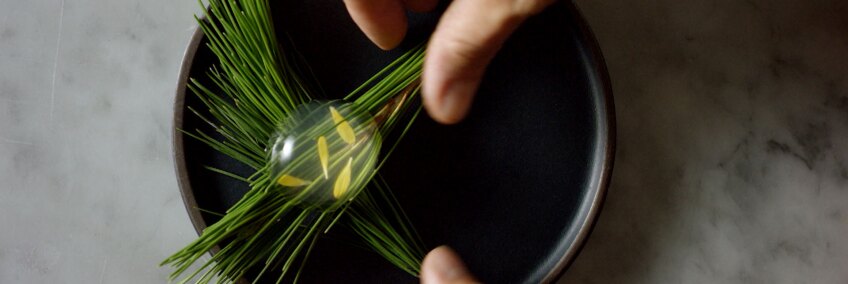Hank and Bean: Expanding Our Diets

As chefs, Henry Fischer and Anna Rose Hopkins have vastly different backgrounds. Fischer, who was born in Germany, had been working in kitchens since his teens and had accumulated loads of restaurant experience. Hopkins' background was as a private chef; She worked heavily in developing menus for people with restricted diets. Eventually, they ended up working together and, in that time, they decided to forge their own path as Hank and Bean. Together, they design meals for private parties and public events.
"Part of what we do in our practice together is seek out collaborations with artists and create immersive dining experiences," says Hopkins by phone. That can be anything from imagining a dinner on Mars to their work as part of artist Marina Zurkow's series, "Making the Best of It: Nimble Food for Climate Chaos." For the latter project, which is featured in “Broken Bread,” Hank and Bean were tasked with creating a menu that incorporated jellyfish.
"Our research started by looking at ancient and modern-day culinary practices with jellyfish," says Hopkins. That turned up some interesting results. Cannonball jellyfish, she says, are used in Asian cuisines. Those can be found near North Carolina and in the Gulf of Mexico, but, Hopkins notes, those are often sent to processors in Asia and sometimes come back to markets in the U.S.


More About Broken Bread

Meanwhile, the moon jellyfish is found off California's coast. They first tried to find some in the wild. Then, they discovered a commercial jellyfish husbandry lab in Signal Hill. "All of a sudden, we had come full circle to our backyard, to a sustainable aquaculture project," says Hopkins. From there, they experimented on how to prepare the jellyfish, says Fischer by phone, "just to see what we can do with them and what products can be made and what the stability of them is and how you can make it more interesting for the average American consumer as a texture play and as the next best thing in comparison to meats like beef and chicken."
Hopkins says that, while jellyfish worked within the project as a metaphor for climate change, they aren't the most nutritious substitute for more common meats. "It doesn't have the same kind of nutrition as an edible insect, like a cricket or a mealworm," she says. But, the duo has worked with those as well.

Fischer says he finds inspiration in taking unusual foods, even items that might normally make Americans squeamish, and transforming them into more appetizing forms. The mealworm is an example of this. "When you roast it and when you bake with it, say when you make a bread with it, it tastes very much like bran flour, or you could make it taste like a bran muffin," he explains, "but truly it's fortified with mealworm or cricket and it has a high amount of protein."
"I would say that in 2019, it's pretty easy to satisfy someone with six ounces of kobe beef and really good French butter and herbs that you picked from your garden," says Hopkins. "Maybe that's not as interesting to us as practitioners who are thinking in a more macro way about the environment and also want to play with what food can be."




